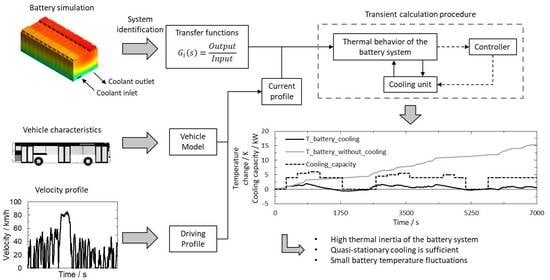Liquid-Based Battery Temperature Control of Electric Buses
Abstract
1. Introduction
2. Methodology
2.1. Driving Profile
2.2. Vehicle Model
2.3. 3D Thermo-Hydraulic Simulation Model
2.4. Transient Calculation
2.4.1. System Identification
2.4.2. System Simulation and Control
3. Results and Discussion
3.1. Transfer Function
3.1.1. Investigation of the Transfer Functions
3.1.2. Transient Validation
3.2. Driving Cycle Study
3.2.1. Current Profile
3.2.2. Thermal Behavior
- The battery cell temperature is controlled according to the control strategy and restrictions of the battery cooling unit described in Section 2.4.2 (with cooling).
- The coolant is circulated but not cooled (without cooling).
4. Conclusions
Author Contributions
Funding
Acknowledgments
Conflicts of Interest
Appendix A

Appendix B
| Quality Criteria | Average | Minimal Value |
|---|---|---|
| skewness | 0.6712 | 0.127 |
| volume vs. circumradius | 0.6914 | 0.1427 |
| volume vs. length | 0.7821 | 0.1579 |
| condition number | 0.8395 | 0.1828 |
| growth rate | 0.6682 | 0.2575 |
| maximum angle | 0.7412 | 0.127 |
Appendix C


References
- Martin, J. The 17 Great Challenges of the Twenty-First Century. Oxford University 2007. Available online: https://www.elon.edu/docs/e-web/predictions/17_Great_Challenges.pdf (accessed on 14 August 2020).
- IEA. CO2 Emissions from Fuel Combustion 2016. International Energy Agency 2016. Available online: https://www.oecd-ilibrary.org/energy/co2-emissions-from-fuel-combustion-2016_co2_fuel-2016-en (accessed on 14 August 2020).
- Creutzig, F.; Jochem, P.; Edelenbosch, O.Y.; Mattauch, L.; van Vuuren, D.P.; McCollum, D.; Minx, J. Transport: A roadblock to climate change mitigation? Science 2015, 350, 911–912. [Google Scholar] [CrossRef] [PubMed]
- Clairand, J.-M.; Guerra-Terán, P.; Serrano Guerrero, X.; Gonzalez, M.; Escrivá, G. Electric Vehicles for Public Transportation in Power Systems: A Review of Methodologies. Energies 2019, 12, 3114. [Google Scholar] [CrossRef]
- Li, J.-Q. Battery-electric transit bus developments and operations: A review. Int. J. Sustain. Transp. 2016, 10, 157–169. [Google Scholar] [CrossRef]
- Xu, X.; Lv, X.; Han, L. Carbon Asset of Electrification: Valuing the Transition from Fossil Fuel-Powered Buses to Battery Electric Buses in Beijing. Sustainability 2019, 11, 2749. [Google Scholar] [CrossRef]
- Zhou, B.; Wu, Y.; Zhou, B.; Wang, R.; Ke, W.; Zhang, S.; Hao, J. Real-world performance of battery electric buses and their life-cycle benefits with respect to energy consumption and carbon dioxide emissions. Energy 2016, 96, 603–613. [Google Scholar] [CrossRef]
- Pesaran, A.; Santhanagopalan, S.; Kim, G.-H. Addressing the Impact of Temperature Extremes on Large Format Li-Ion Batteries for Vehicle Applications. In Proceedings of the 30th international battery seminar, Ft.Lauderdale, FL, USA, 11–14 March 2013; Available online: https://www.nrel.gov/docs/fy13osti/58145.pdf (accessed on 16 August 2020).
- Pesaran, A.A. Battery thermal models for hybrid vehicle simulations. J. Power Sources 2002, 110, 377–382. [Google Scholar] [CrossRef]
- Kim, J.; Oh, J.; Lee, H. Review on battery thermal management system for electric vehicles. Appl. Therm. Eng. 2019, 149, 192–212. [Google Scholar] [CrossRef]
- Lu, M.; Zhang, X.; Ji, J.; Xu, X.; Zhang, Y. Research progress on power battery cooling technology for electric vehicles. J. Energy Storage 2020, 27, 101155. [Google Scholar] [CrossRef]
- Wu, W.; Wang, S.; Wu, W.; Chen, K.; Hong, S.; Lai, Y. A critical review of battery thermal performance and liquid based battery thermal management. Energy Convers. Manag. 2019, 182, 262–281. [Google Scholar] [CrossRef]
- Bernardi, D.M.; Pawlikowski, E.M.; Newman, J. A General Energy Balance for Battery Systems. J. Electrochem. Soc. 1985, 132, 5. [Google Scholar] [CrossRef]
- Wang, Q.; Jiang, B.; Li, B.; Yan, Y. A critical review of thermal management models and solutions of lithium-ion batteries for the development of pure electric vehicles. Renew. Sustain. Energy Rev. 2016, 64, 106–128. [Google Scholar] [CrossRef]
- Xiao, Y.; Torregrossa, D.; Paolone, M. Surface temperature estimation of li-ion battery via thermal impulse response technique. In Proceedings of the IEEE Applied Power Electronics Conference and Exposition (APEC), Charlotte, NC, USA, 15–19 March 2015; pp. 1089–1095. [Google Scholar]
- Hu, X.; Lin, S.; Stanton, S.; Lian, W. A Foster Network Thermal Model for HEV/EV Battery Modeling. IEEE Trans. Ind. Appl. 2011, 47, 1692–1699. [Google Scholar] [CrossRef]
- Che-Daud, Z.; Asus, Z.; Abu Bakar, S.A.; Abu Husain, N.; Mohd Samin, P.; Chrenko, D. Temperature Prediction of Lithium-Ion Battery Used in Realistic Driving Cycles. In Proceedings of the IEEE Vehicle Power and Propulsion Conference (VPPC), Belfort, France, 11–14 December 2017; pp. 1–4. [Google Scholar]
- Worwood, D.; Kellner, Q.; Wojtala, M.; Widanage, W.; MGlen, R.; Greenwood, D.; Marco, J. A new approach to the internal thermal management of cylindrical battery cells for automotive applications. J. Power Sources 2017, 346, 151–166. [Google Scholar] [CrossRef]
- Tourani, A.; White, P.; Ivey, P. Analysis of electric and thermal behaviour of lithium-ion cells in realistic driving cycles. J. Power Sources 2014, 268, 301–314. [Google Scholar] [CrossRef]
- Hosseinzadeh, E.; Genieser, R.; Worwood, D.; Barai, A.; Marco, J.; Jennings, P. A systematic approach for electrochemical-thermal modelling of a large format lithium-ion battery for electric vehicle application. J. Power Sources 2018, 382, 77–94. [Google Scholar] [CrossRef]
- Torregrossa, D.; Xiao, Y.; Fahimi, B.; Paolone, M. Nonparametric Estimation of Surface Temperature of Li-Ion Cells Using Thermal Impulse Response. IEEE Trans. Transp. Electrif. 2016, 2, 407–416. [Google Scholar] [CrossRef]
- Lajunen, A.; Kalttonen, A. Investigation of thermal energy losses in the powertrain of an electric city bus. In Proceedings of the IEEE Transportation Electrification Conference and Expo (ITEC), Dearborn, MI, USA, 14–17 June 2015; pp. 1–6. [Google Scholar]
- Wu, X.; Lv, S.; Chen, J. Determination of the Optimum Heat Transfer Coefficient and Temperature Rise Analysis for a Lithium-Ion Battery under the Conditions of Harbin City Bus Driving Cycles. Energies 2017, 10, 1723. [Google Scholar] [CrossRef]
- Angermeier, S.; Heik, J.; Kerler, B.; Karcher, C. Investigation into heat transfer of a fluid-cooled battery depending on driving profile of electric buses via thermal impulse response technique. In Proceedings of the 14th International Conference of Heat Transfer, Fluid Mechanics and Thermodynamics, Wicklow, Ireland, 22–24 July 2019; Available online: https://na.eventscloud.com/ehome/349879/program/?&t=37e84e64acfd67aa345e8e3046e4d5ab (accessed on 16 August 2020).
- Simcenter Amesim, Siemens AG. Available online: https://www.plm.automation.siemens.com/global/en/products/simcenter/simcenter-amesim.html (accessed on 16 August 2020).
- Tao, X.W.; Wagner, J. A thermal management system for the battery pack of a hybrid electric vehicle: Modeling and control. Proc. Inst. Mech. Eng. Part D J. Automob. Eng. 2016, 230, 190–201. [Google Scholar] [CrossRef]
- Gao, X.; Ma, Y.; Chen, H. Active Thermal Control of a Battery Pack Under Elevated Temperatures. IFAC-PapersOnLine 2018, 51, 262–267. [Google Scholar] [CrossRef]
- UITP: Union Internationale des Transports Publics. Available online: https://www.uitp.org/ (accessed on 16 August 2020).
- Mahle Group. Internal Material of the Mahle GmbH. Available online: https://www.mahle.com/en/ (accessed on 16 August 2020).
- Daimler, eCitaro Specification. Available online: https://www.mercedes-benz-bus.com/de_DE/models/ecitaro/facts/technical-data.html (accessed on 16 August 2020).
- Lajunen, A. Energy consumption and cost-benefit analysis of hybrid and electric city buses. Transp. Res. Part C Emerg. Technol. 2014, 38, 1–15. [Google Scholar] [CrossRef]
- Lindh, P.; Petrov, I.; Immonen, P.; Pyrhönen, J.; Niemelä, M.; Anttila, J.; Paakkinen, M.; Scherman, E. Performance of a Direct-Liquid-Cooled Motor in an Electric Bus Under Different Load Cycles. IEEE Access 2019, 7, 86897–86905. [Google Scholar] [CrossRef]
- Basma, H.; Mansour, C.; Haddad, M.; Nemer, M.; Stabat, P. Comprehensive energy modeling methodology for battery electric buses. Energy 2020, 207, 118241. [Google Scholar] [CrossRef]
- Sinhuber, P.; Rohlfs, W.; Sauer, D.U. Study on power and energy demand for sizing the energy storage systems for electrified local public transport buses. In Proceedings of the IEEE Vehicle Power and Propulsion Conference, Seoul, Korea, 9–12 October 2012; pp. 315–320. [Google Scholar]
- Vepsäläinen, J.; Otto, K.; Lajunen, A.; Tammi, K. Computationally efficient model for energy demand prediction of electric city bus in varying operating conditions. Energy 2019, 169, 433–443. [Google Scholar] [CrossRef]
- Hu, X.; Murgovski, N.; Johannesson, L.; Egardt, B. Energy efficiency analysis of a series plug-in hybrid electric bus with different energy management strategies and battery sizes. Appl. Energy 2013, 111, 1001–1009. [Google Scholar] [CrossRef]
- Fletcher, L. A Review of Thermal Control Materials for Metallic Junctions. J. Spacecr. 1972, 9. [Google Scholar] [CrossRef]
- Loges, A.; Herberger, S.; Werner, D.; Wetzel, T. Thermal characterization of Li-ion cell electrodes by photothermal deflection spectroscopy. J. Power Sources 2016, 325, 104–115. [Google Scholar] [CrossRef]
- Richter, F.; Vie, P.J.; Kjelstrup, S.; Burheim, O.S. Measurements of ageing and thermal conductivity in a secondary NMC-hard carbon Li-ion battery and the impact on internal temperature profiles. Electrochim. Acta 2017, 250, 228–237. [Google Scholar] [CrossRef]
- Viswanathan, V.V.; Choi, D.; Wang, D.; Xu, W.; Towne, S.; Williford, R.E.; Zhang, J.-G.; Liu, J.; Yang, Z. Effect of entropy change of lithium intercalation in cathodes and anodes on Li-ion battery thermal management. J. Power Sources 2010, 195, 3720–3729. [Google Scholar] [CrossRef]
- Hu, C.; Lin, S.; Stanton, S.; Lian, W. A state space thermal model for HEV/EV non-linear and time varying batter thermal system. In Proceedings of the ASME 2011 International Mechanical Engineering Congress & Exposition, Denver, CO, USA, 11–17 November 2011; pp. 783–791. [Google Scholar]
- Pintelon, R.; Schoukens, J. System Identification: A Frequency Response Approach; IEEE Press: New York, NY, USA, 2001. [Google Scholar] [CrossRef]
- De Keyser, R.; Ionescu, C.M.; Festila, C. A one-step procedure for frequency response estimation based on a Switch-Mode Transfer Function Analyzer. In Proceedings of the 50th IEEE Conference on Decision and Control and European Control Conference, Orlando, FL, USA, 12–15 December 2011; pp. 1189–1194. [Google Scholar]
- Hipp, C.; Mückle, S.; Schauer, M.; Segal, D.; Zimmermann, R. System for Controlling the Temperature of an Electric Energy Storage Device. Patent Nr. WO 2019/016021 A2 2019. Available online: https://patentimages.storage.googleapis.com/77/97/f2/7be732563f0615/WO2019016021A2.pdf (accessed on 4 September 2020).
- Baehr, H.D.; Stephan, K. Heat conduction and mass diffusion. In Heat and Mass Transfer, 3rd ed.; Springer: Berlin/Heidelberg, Germany, 2011; pp. 158–161. [Google Scholar]
- Heik, J. Numerische Analyse des Thermischen Verhaltens Prismatischer Li-Ion-Zellen in Abhängigkeit Standardisierter Fahrprofile von E-Bussen, Masterthesis, University of Ilmenau, Ilmenau, Germany. 2019. Available online: https://opac.lbs-ilmenau.gbv.de/DB=1/CMD?ACT=SRCHA&IKT=1016&SRT=YOP&TRM=Julius+Heik (accessed on 4 September 2020).



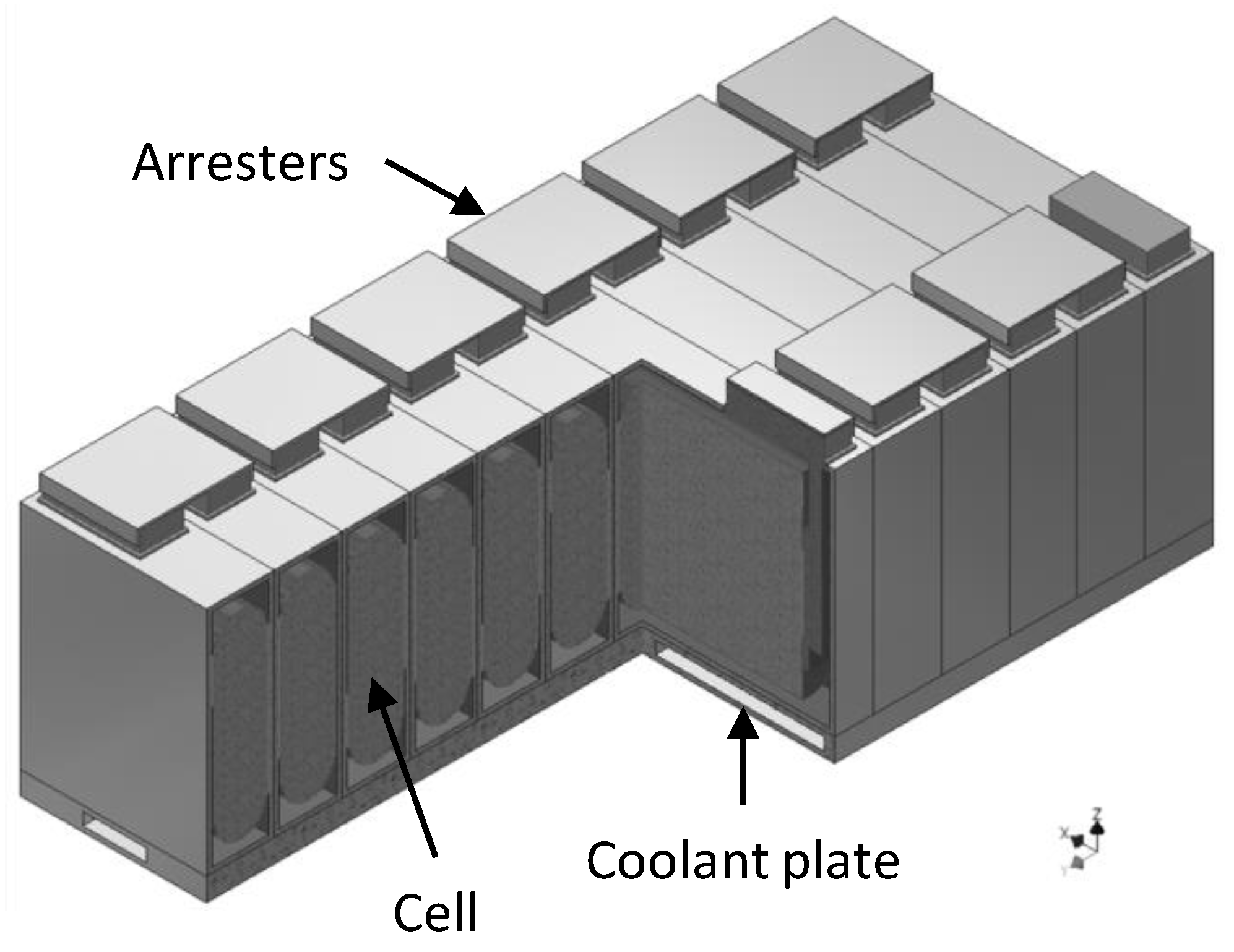
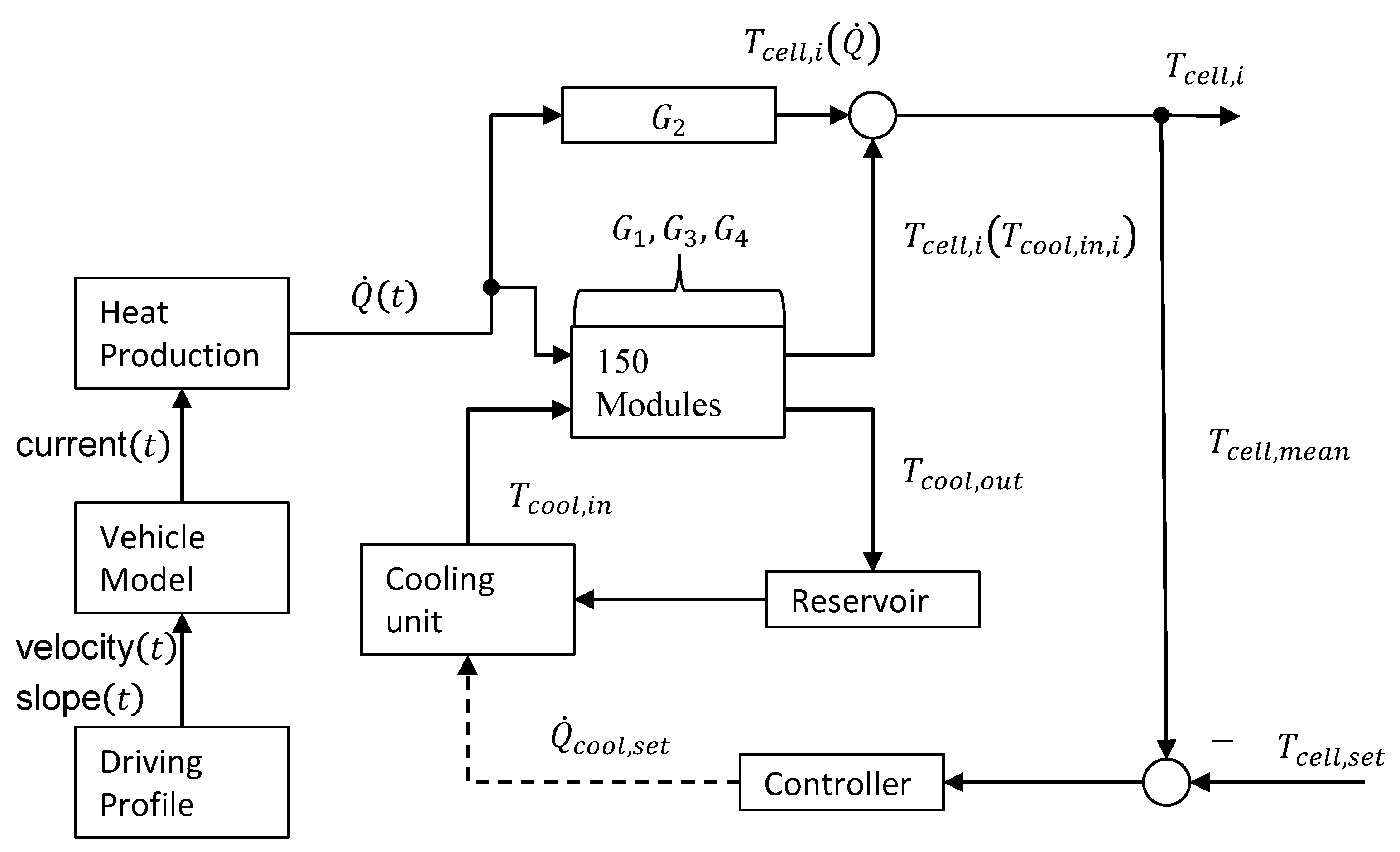

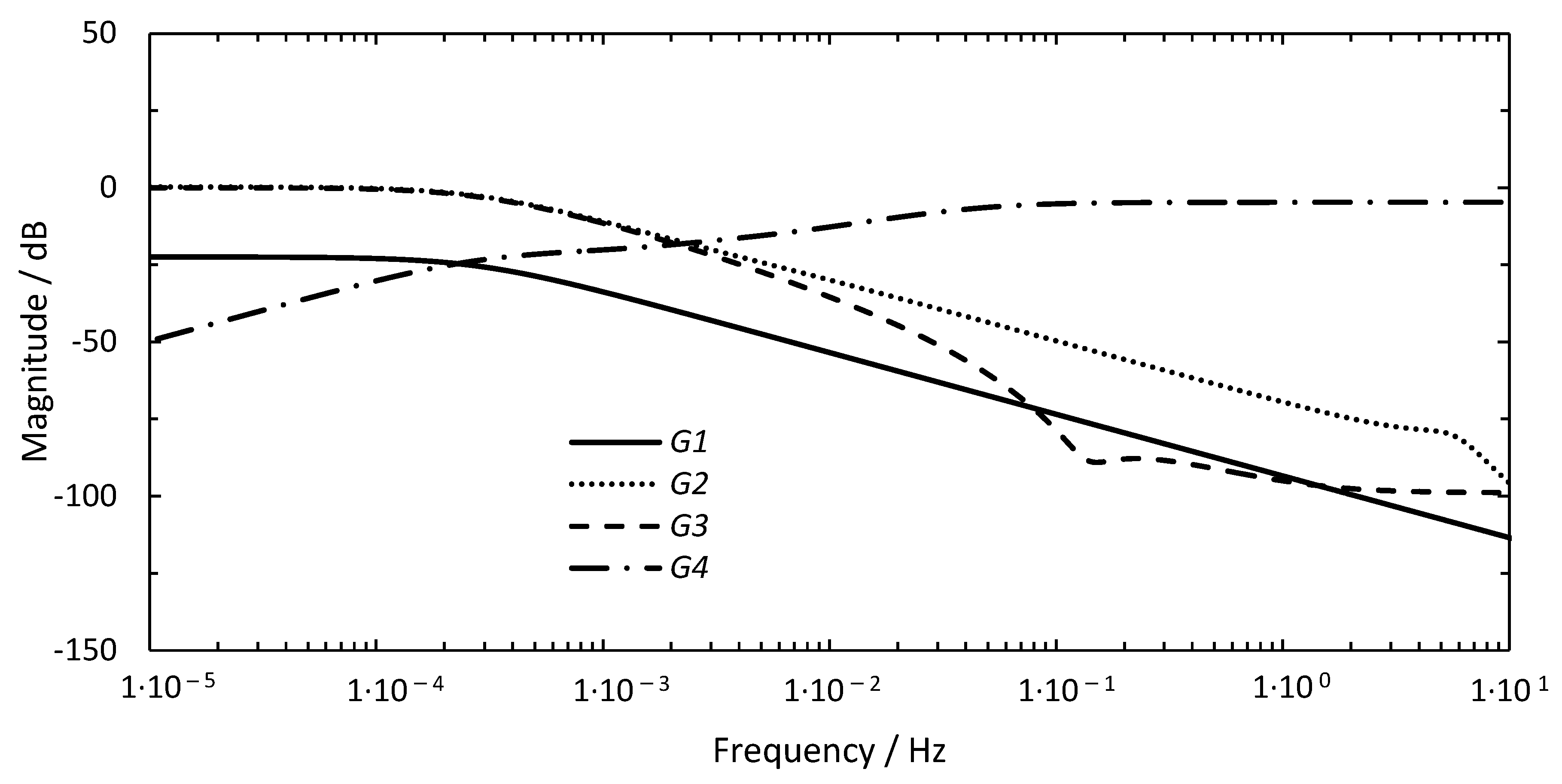







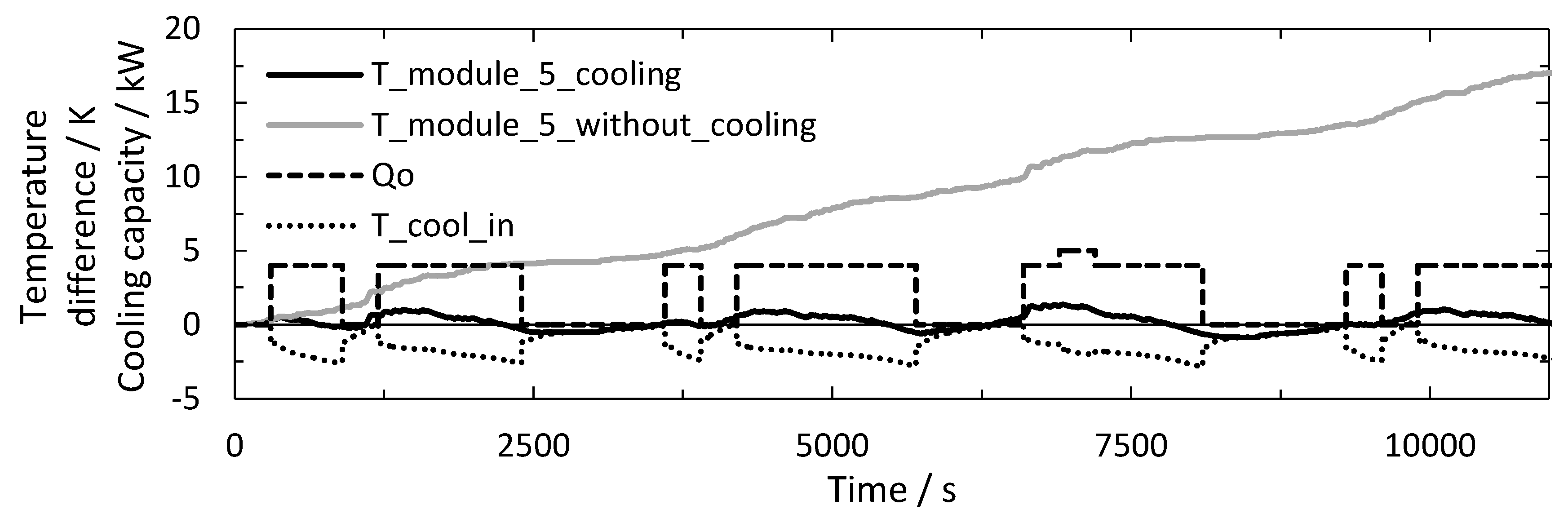

| Characteristic | 5 Times SORT2 | Line 84 | Line 92 |
|---|---|---|---|
| Maximum speed/km/h | 50 | 85.36 | 63.6 |
| Average total speed/km/h | 18.01 | 30.63 | 26.22 |
| Average speed/km/h | 29.52 | 38.91 | 34.92 |
| Distance/km | 4.6 | 13 | 40 |
| Total elevation/m | 0 | 570 | 720 |
| Time/s | 919.5 | 3500 | 5500 |
| Stops | 15 | 32 | 50 |
| Aggressiveness A/m/s2 [22] | 0.19 | 0.2 | 0.17 |
| Quantity | Symbol | Value |
|---|---|---|
| Electric Bus | ||
| Total vehicle weight | 20,000 kg [30] | |
| Cross-section area | 7.65 m2 | |
| Air density | 1.2 kg/m3 | |
| Rolling resistance coefficient | 0.01 [31] | |
| Drag coefficient | 0.57 [31,32] | |
| Electric machine efficiency | 90% [32,33] | |
| Gear efficiency | 96% [23,32] | |
| Power electronic efficiency | 95% [23,34] | |
| Battery efficiency | 95% [32] | |
| Auxiliary power consumption | 12 kW [35] | |
| Recuperation rate | 40% [36] | |
| Battery System | ||
| Battery pack capacity | 250 kWh | |
| Battery pack voltage | 666 V | |
| Amount battery modules | 150 | |
| Amount battery cells per module | 12 | |
| Battery module voltage | 44.4 V | |
| Cell capacity | 37 Ah | |
| Cell voltage | 3.7 V |
| Parameter | Unit | Value |
|---|---|---|
| Density | [kg/m3] | 2100 [38] |
| Specific heat capacity | [J/kgK] | 1050 [38] |
| Conduction along electrode | [W/mK] | 28 [38] |
| Conduction cross electrode | [W/mK] | 0.4 [38] |
| Internal resistance | [mOhm] | 4 [39] |
| Entropy coefficient | [J/molK] | 9.4 [40] |
© 2020 by the authors. Licensee MDPI, Basel, Switzerland. This article is an open access article distributed under the terms and conditions of the Creative Commons Attribution (CC BY) license (http://creativecommons.org/licenses/by/4.0/).
Share and Cite
Angermeier, S.; Ketterer, J.; Karcher, C. Liquid-Based Battery Temperature Control of Electric Buses. Energies 2020, 13, 4990. https://doi.org/10.3390/en13194990
Angermeier S, Ketterer J, Karcher C. Liquid-Based Battery Temperature Control of Electric Buses. Energies. 2020; 13(19):4990. https://doi.org/10.3390/en13194990
Chicago/Turabian StyleAngermeier, Sebastian, Jonas Ketterer, and Christian Karcher. 2020. "Liquid-Based Battery Temperature Control of Electric Buses" Energies 13, no. 19: 4990. https://doi.org/10.3390/en13194990
APA StyleAngermeier, S., Ketterer, J., & Karcher, C. (2020). Liquid-Based Battery Temperature Control of Electric Buses. Energies, 13(19), 4990. https://doi.org/10.3390/en13194990




